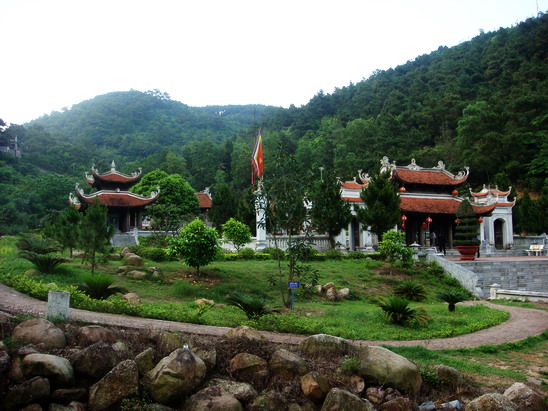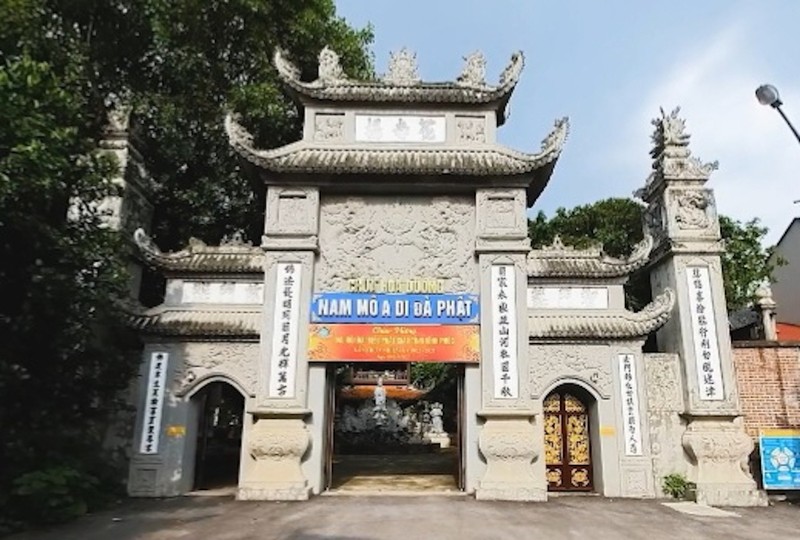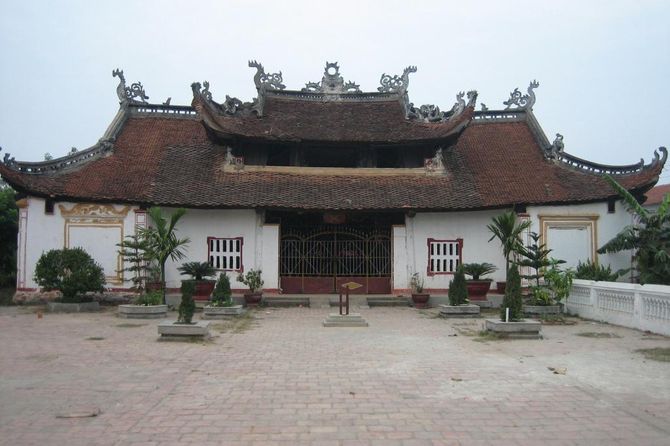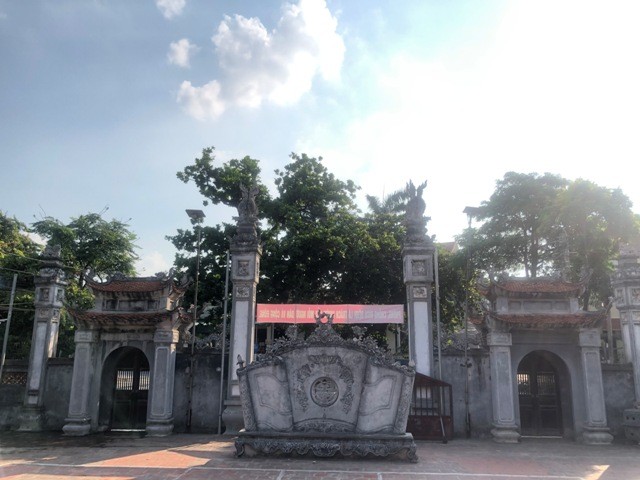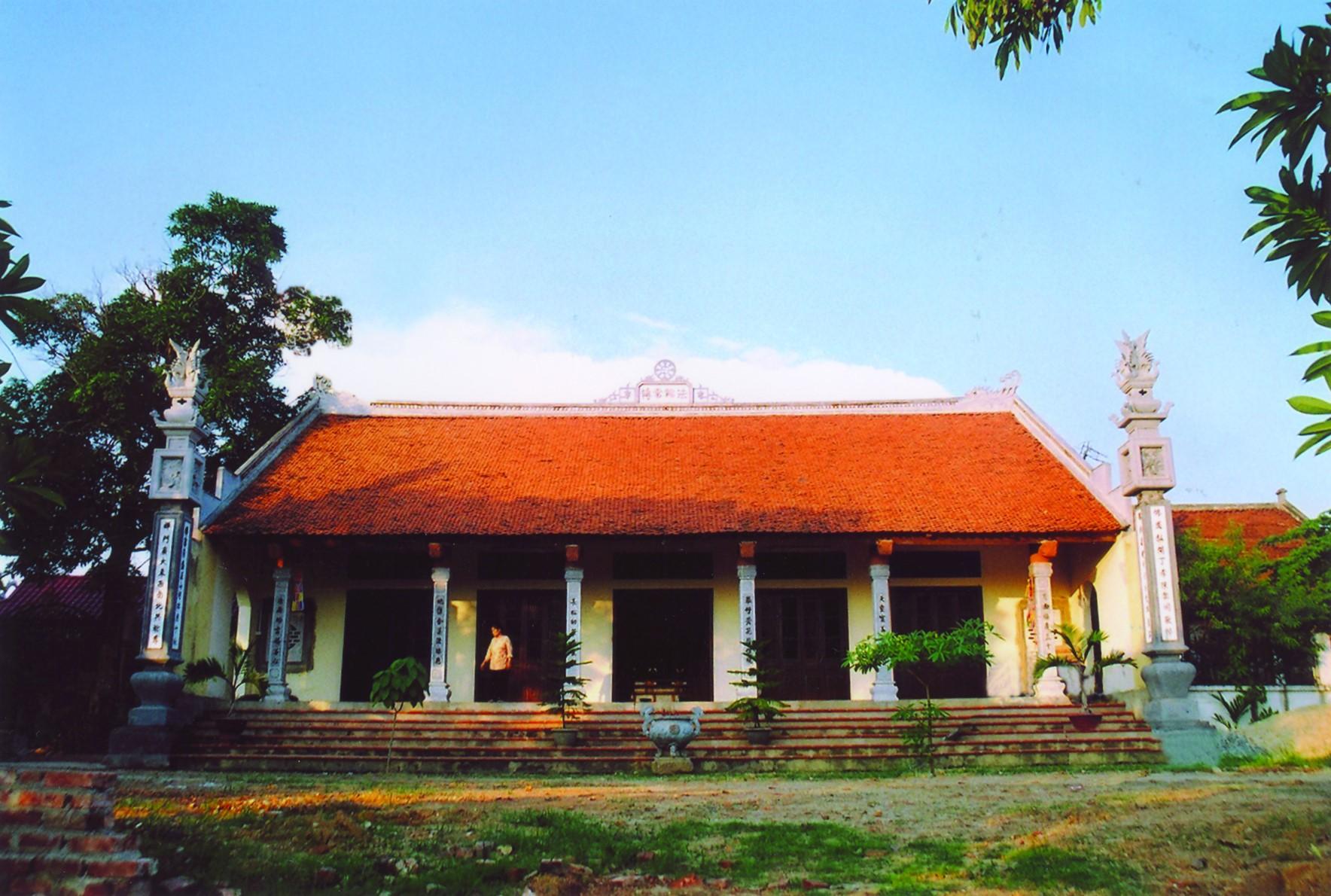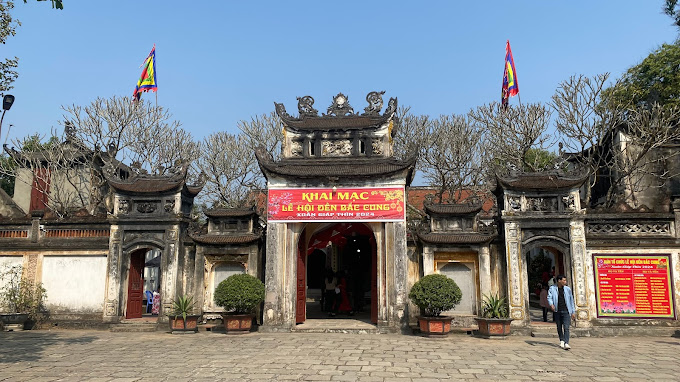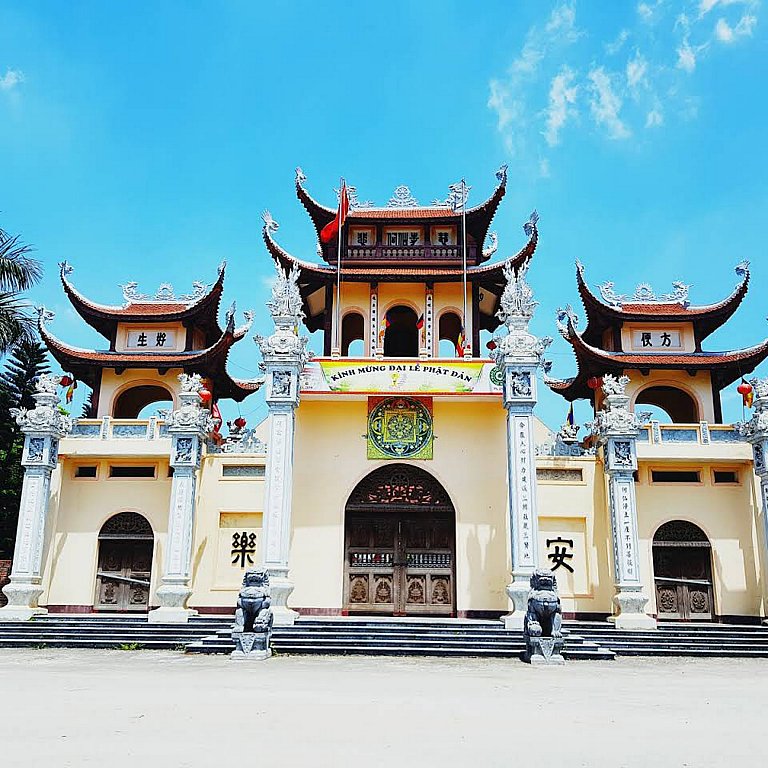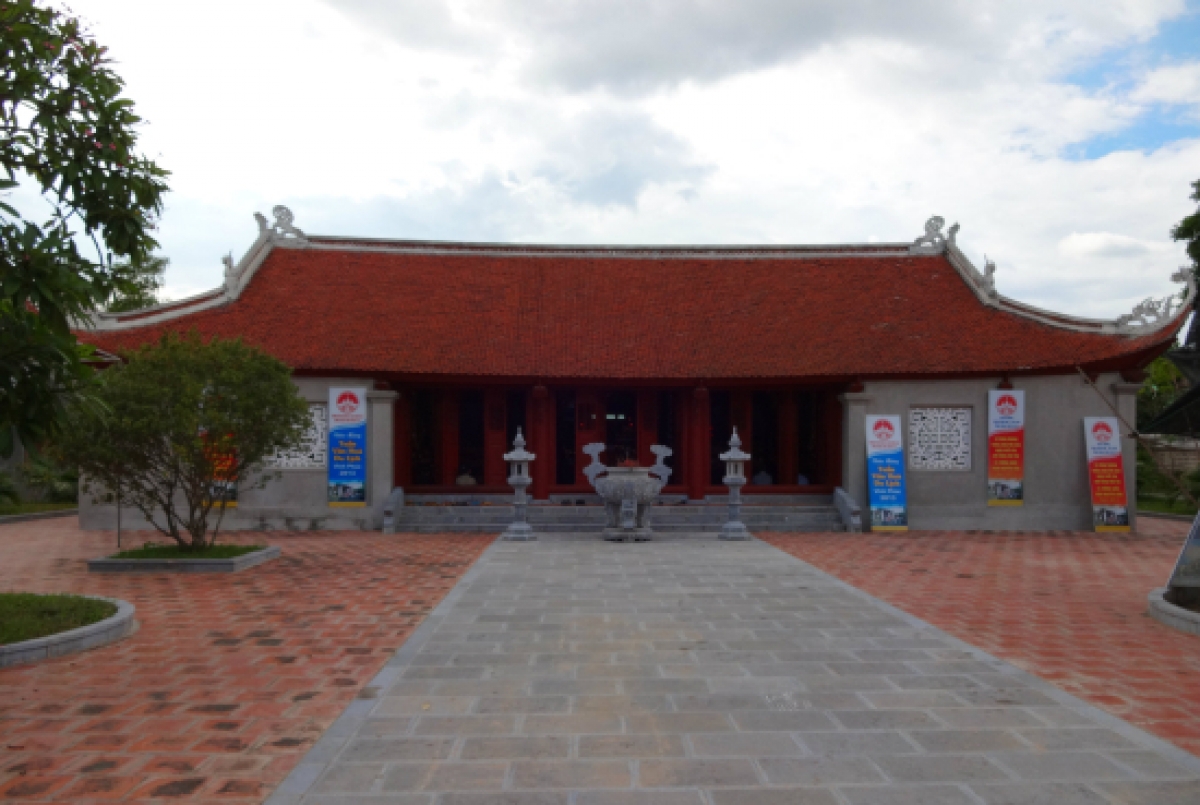Relic point Vietnam
Việt NamAn Phu - Kinh Chu - Nham Duong relic area
The An Phu - Kinh Chu - Nham Duong relic complex in Kinh Mon district, Hai Duong province has long been known for its rare historical, cultural and scenic values. On December 22, 2016, the Prime Minister signed a decision to classify the historical relics and scenic spots of An Phu - Kinh Chu - Nham Duong complex as a special national monument. Cao Temple, located on the highest peak of An Phu range, is the highlight of the An Phu - Kinh Chu - Nham Duong relic complex. Cao An Phu Temple belongs to An Sinh commune, built in the Tran dynasty (13th century), worshiping An Sinh Vuong Tran Lieu - father of Hung Dao Dai Vuong Tran Quoc Tuan. In the grounds of Cao An Phu temple, there is also Tuong Van pagoda worshiping Buddha and Emperor Tran Nhan Tong - founder of the Truc Lam Yen Tu Zen sect. About 50m lower than An Phu Temple and about 300m in front is the nearly 13m high stone statue of Hung Dao Dai Vuong Tran Quoc Tuan, standing with his sword in his hand, holding a book in his hand, eyes facing the northeastern border of Vietnam. Country. The project was built by the People's Committee of Hai Duong province in 1993 with General Vo Nguyen Giap laying the first stone. The monument area also has a terracotta bas-relief 45m long, 2.5m high, consisting of 265 pieces assembled, depicting the resistance war against the Mongols of the Dai Viet army and people by ceramic artists in Cay village, Binh Giang district (Hai Duong) participated in the production. Kinh Chu Cave has long been classified as one of the six beautiful caves of the Southern Heavens. Kinh Chu Cave is located in the Duong Nham limestone mountain range (Pham Menh commune) with towering lance-shaped rocks. The cave is located on the south side of the mountain, through 36 stone steps, opening up with 3 large cave doors. The cave space exposes wonderfully arranged stalactites created by nature. With a natural scene like the realm of bliss, the cave was created by ancient people into a temple to worship Buddha. On the left side of the cave, there are four big words "Van Thach book room" (Van Thach Bookstore) which is the reading place of Pham Su Manh, a famous mandarin during the Tran Dynasty. In Kinh Chu, there are also many unique caves such as Vang cave, Luon cave, Tien Su cave... with endless legendary stories. Kinh Chu is also attractive because of more than 40 unique Ma Nhai epitaphs carved into the cliffs. Notably, the horizontal rectangular stele on the roof of the cave is engraved with a poem by King Le Thanh Tong (1442 - 1497), the host of the Tao Dan festival when he visited this place. Nham Duong (Duy Tan commune) is a place of magnificent mountain landscapes with dozens of caves: Thanh Hoa cave, Tinh Niem cave, Chieng cave, Trong cave, Toi cave... These caves store artifacts of Prehistory attracts the attention of archaeologists. At Thanh Hoa cave behind the pagoda, in 2000, people found many fossil bones of elephants, rhinos, monkeys, wild boar, especially ape bones..., a total of 17 species of animals belonging to the Quaternary period, about us 3-5 thousand years. In addition, many human bones were discovered stuck to the cave walls covered by stalactites, belonging to the prehistoric period tens of thousands of years ago. There is also an ancient temple built during the Tran Dynasty (1225 - 1400), which is the ancestral home of the Taoist Zen sect, which contributed to the revival of Vietnamese Buddhism. The pagoda also preserves two stone towers of the Le Dynasty containing the relics of the first Zen Master Thuy Nguyet and the second Patriarch Tong Dien. Source: Hai Duong province electronic information portal
Hai Phong 3753 view
Con Son - Kiep Bac
Con Son - Kiep Bac relic is located in Chi Linh city, Hai Duong province, recognized as a special national relic in 2012. This place includes a complex of historical relics related to glorious victories. Three times, the army and people of the Tran Dynasty defeated the Yuan Mongol invaders in the 13th century and in the 10-year resistance war of the Lam Son insurgent army against the Ming army in the 15th century. This is a place associated with the lives and careers of national heroes Nguyen Trai and Tran Hung Dao along with many cultural celebrities of the nation: Tran Nguyen Dan, Phap Loa, Huyen Quang... Highlights of the relic site These relics are Con Son pagoda and Kiep Bac temple. Con Son Pagoda in Cong Hoa ward, Chi Linh city, is one of the Buddhist centers of the Truc Lam Dai Viet Zen sect founded by Dieu Ngu Giac Hoang Tran Nhan Tong in the 13th century. The pagoda's architecture is in the style of Gong script, including Tien Duong, Thieu Luong, and Upper Dien, which is a place to worship Buddha, including Buddha statues from the Le Dynasty up to 3 meters high. The road to Tam Quan is paved with bricks, running long under hundreds of years of weathered pine trees interspersed with lush, dark green lychee canopy. The three-entrance gate was renovated in 1995, in an ancient style, with 2 floors and 8 roofs with stylized floral and rattan motifs of the architectural art of the Le Dynasty. Nguyen Trai Temple, construction started on December 14, 2000, on a land area of nearly 10,000 square meters, at the foot of Ngu Nhac Mountain, located in the Thanh Hu Dong area and near the place where Mrs. Tran's temple used to be in the past. Thi Thai, Nguyen Trai's mother. On the right side is the Con Son stream flowing from North to South, winding from right to left, embracing the Temple area. The main temple leans back on To Son, on both sides leaning against the Ngu Nhac and Ky Lan mountain ranges, the left is Thanh Long and the right is White Tiger. In front there is a large lake, next is Truc Thon mountain opposite Phuong Hoang mountain. In the distance is the An Lac mountain range. Kiep Bac Temple is located in the two villages Duoc Son and Van Kiep, Hung Dao commune, Chi Linh city, and is the place to worship Hung Dao Dai Vuong Tran Quoc Tuan. Kiep Bac is the compound name of two regions: Van Yen (Kiep village) and Duoc Son (Bac village). This is an important relic in the Con Son - Kiep Bac relic area. The Kiep Bac temple area is a rich valley surrounded by the Dragon Mountains on three sides, and Luc Dau Giang on one side. Mountains form a posture of flanking dragons and tigers, and rivers form spacious halls. In front of the temple there is a large gate with three magnificent and massive doors. On the front of the gate, there are four words "Hung Thien Infinity", below there are 5 words "Tran Hung Dao Vuong tu". In the 13th century, this was where Hung Dao Dai Vuong Tran Quoc Tuan established a base, stored food, and trained soldiers in the resistance wars against the Mongols. In the 14th century, his temple was built here and was the place to organize annual festivals to offer incense to commemorate the hero of the Vietnamese nation, who had great contributions to the country and was revered by the people. is Saint Tran. Source: Hai Duong province electronic information portal
Hai Phong 4441 view
Hoa Duong Pagoda
Hoa Duong Pagoda is in Tuan Lo commune, Tuan Lo district, Bach Hac district, Tam Doi district, Son Tay town. Now it is Thuong village, Tuan Chinh commune, Vinh Tuong district. The pagoda was built in the first year of Chinh Hoa (Canh Than 1680), during the reign of King Le Hy Tong Duy Hiep. Hoa Duong Pagoda was built in the Later Le Dynasty, in 1680. What remains today is a relic with quite massive and magnificent architecture, with a "cong" shaped floor plan consisting of 3 main buildings: Front Street (7 compartments). ), the upper palace (4 compartments) and the ancestral house (5 compartments), total area of 262m2 with 2 corridors including 20 compartments with an area of 196m2, in front of the yard is a hundred year old Bodhi tree and tree species: Dai, Ngau, Lan, and Crocodile create a solemn, somber atmosphere at the meditation door. Architecturally: The structure of the rafters is in the style of "stacking beams and gongs", the load-bearing column system is all made of large ironwood, the column circumference is 1.5m and is placed on square stone bases, each 75cm big to Anti-termite and anti-moisture. Regarding fine arts: The outstanding value of Hoa Duong Pagoda is the art of sculpture, expressed in the system of round statues and wooden sculptures (y subjects, shelf paintings, horizontal panels, parallel sentences). These are the basic classes of statues, generally representing the system of statues arranged in a Buddhist temple according to the Mahayana sect in Northern Vietnam, including the following classes: Set of statues of the Three Buddhas, Amitabha Buddha, Three Buddhas, Sakyamuni Buddha, Four Bodhisattvas, Four Heavenly Kings, Statues of Monsignors, Saints, Dharma Protectors and Patriarch Buddha statues. All Buddha statues are made from old, intact jackfruit wood, with elaborate, meticulous techniques, creative and skillful art, demonstrating high artistic aesthetic thinking ability and perfect harmony in perception. the absolute "emptiness" value of Buddha Dharma. The values of truth, goodness, and beauty of Buddhism originate from the simple truths of everyday life through thousands of years of cultivation, fostering, and transmission, and have become a fundamental part of the Vietnamese soul. The soul of the artist when giving life to statues made of wood, stone, or soil becomes shimmering, fanciful but very real for each person when entering the temple to worship Buddha. The wood sculptures include: 8 paintings of y mon (horizontal sea) all of the same size (3.0m long, 0.6m wide) embossed, lacquered and gilded with natural themes: flowers, leaves, clouds, Ancient trees, birds and animals are extremely close, natural and lively, in the middle are carved "great characters" with the meaning of praise and teaching, interwoven between Buddhism and Confucian philosophy. The 8 "Shelf paintings" engraved with verses in Chinese characters with content about natural landscapes and topics related to the propagation of Buddhism, are excellent poems embedded in talented sculptures, on The background of carving techniques, liberal decoration, harmonious layout, and beautiful painting is worthy of being a legacy for future generations to admire and reflect on. 8 sets of horizontal panels, parallel sentences lacquered with gold, precise and neat sentences, profound meaning, comprehensive semantics, sincere heart, true goodness. Along with ancient relics: bronze bells, incense sticks, stone stele, etc. are also ancient written documents on stone that will be preserved forever for future generations, tourists from all over, Buddhist monks and nuns to find opportunities to admire. worshiping in the quiet meditation scene hidden in the countryside. Hoa Duong Pagoda has a history of over 300 years old. The pagoda was ranked as a national historical relic on December 12, 1994. Source: Vinh Phuc electronic communication portal
Phu Tho 5950 view
Coi Pagoda
Coi Pagoda, formerly located in Coi village, Hop Thinh commune, Tam Duong district, now belongs to Hoi Hop ward, Vinh Yen city. Coi Pagoda relics are a complete complex of a Buddha hall including: Three gates, pagodas and towers. The three-entrance gate of Coi Pagoda has an architecture of 3 small, compact compartments, with the main load-bearing system being 10 meticulously carved monolithic blue stone columns, 0.25m in diameter, 2.0m high, with 3 rows of column bases, In which, the 2 columns of the middle compartment use ironwood columns extending beyond them to serve as common columns for the 2 roof rafters in a stacked-rail style architecture. Instead of the bottom row of rafters, there is a wooden trap head that comes out to support the roof ship. , the 4 corners of the roof are curved, graceful knife heads hidden in the canopy of green leaves, creating a charming scene. On the two stone pillars in the middle, which are beveled flat on one side, there are inscriptions on each side. Although they have faded over the years, if you look closely, you can still read "Canh Ty, strong spring, auspicious day". According to documents of the Vietnam Fine Arts Museum, the three-entrance gate of Coi Pagoda was built along with Coi Pagoda in the 13th century. The original Coi Pagoda no longer exists, now there are only 12 ancient statues kept at the temple that was rebuilt in the late 20th century, including: 3 Buddha statues, the Amitabha Tam Ton set (Amitabha, Quan). Amitabha Buddha and Mahasthamaprapta Bodhisattva), statues of Venerable Ananda and Shakyamuni Buddha preaching the Dharma, all made of wood, lacquered with gold, round sculpture style of the late 18th century. Tower: A type of Buddhist architecture, one of the characteristics of Buddhism, the tower can be a place to contain relics, paintings, statues or have symbolic meaning, for example: 4 steps up to the tower represent the concept The concept is loving kindness - compassion - joy - renunciation or the 10 levels are statues of the ten realms,... The tower floors represent the means of propagating Buddhism. If it is a tomb tower, the statue represents the grave of a monk or nun, and the 5-petal lotus symbolizes the "Five Buddhas". The Papyrus Tower has 7 floors, 7.70m high, gradually shrinking from the base to the top, each floor shrinks by 20cm on both square sides and height (1 square side of the base is 1.70m long) - the bricks used to build the tower are Bat Trang bricks. , square brick type, 3cm thick, the bricks at the 4 corners of the tower are all beveled up, giving the tower a gentle, elegant curved shape, the adhesive mortar is made from shell lime mixed with molasses - the tower body is plastered. covered with a protective layer of mortar. Legend. Coi Tower was built around the middle of the 18th century, related to the event of the uprising of the Heo District (Nguyen Danh Phuong, 1740 - 1751): In just one night, Nguyen Danh Phuong had his troops finish building the tower and The entire Tien restaurant, in order to gain prestige and win people's hearts against Le Trinh's court, over hundreds of years, an ancient moss color covers the entire tower, further increasing the desire to learn about a new species. Buddhist architecture in Vinh Phuc. Thus, Coi Pagoda was built in the 13th century, and in the 18th century after erecting two towers (now only one remains, due to war destruction) became an architectural whole with artistic value recognized by the Far East. Uncle Co was ranked as a valuable cultural heritage in Vietnam (in 1939). Located in a complex of relics: Dong Dao communal house, Quan Tien, Tien communal house, Ha pagoda, stone bridge... and in the center of Vinh Yen town, Coi tower pagoda will be a destination for sightseeing and research. A large number of tourists from near and far inside and outside the province. Source: Vinh Phuc Tourism Information and Promotion Center
Phu Tho 4060 view
Huong Canh communal house
Huong Canh was originally the name of a commune of An Lang district, Son Tay town in the Later Le dynasty, then was taken as the general name of the Nguyen dynasty and the name of today's town - Huong Canh town (in Binh Xuyen district, Vinh Phuc province). According to folklore, Huong Canh is also called Tam Canh because this is the common name of three Canh villages including: Huong Canh, Ngoc Canh, Tien Canh. The place name Huong Canh also has the ancient name Ke Canh. This name comes from the local rice variety, which has two pointed rays on both sides of the grain. People call those two sharp rays WINGS and the grain of rice is called WINGS, taking the word WING as the name of the village. Initially, there was only one Huong Canh village here. Gradually, the population grew and the village was separated and named Ngoc Canh - a place with Gie Canh rice, rice grains as beautiful as pearls. Finally, when both villages Huong Canh (fragrant Canh rice) and Ngoc Canh (beautiful Canh rice) were densely populated, they expanded to the West and Northwest with another village and took the name Tien Canh, meaning "rice". Early wings”. Three communal houses in the three villages of Huong Canh, Ngoc Canh and Tien Canh are all ranked as national historical and cultural relics and are currently in the process of preparing documents to request special national ranking. The communal houses are located 50m to 100m apart, forming a monumental relic complex, adjacent to National Highway 2A, convenient for sightseeing, tourism and pilgrimage. Regarding the gods worshiped, according to local people's legend, after defeating the invading Southern Han army, Ngo Quyen became king and established the capital in Co Loa (now in Hanoi). The country was independent and at peace, but Ngo Quyen still did not forget to be vigilant and train soldiers and horses to prevent enemies. At that time, hunting was also a form of exercise, so once Ngo Quyen sent his two children, Ngo Xuong Ngap and Ngo Xuong Van, along with his close general Do Canh Thac, to bring troops to conduct an exercise in the form of hunting. They marched through Huong Canh, camped at a mound in the middle of the field, the people called Go Ngu. To record the sacred mark and pay tribute to the heroes of the Ngo Dynasty, the people of Huong Canh built a temple in Go Ngu to worship them, according to the concept of "life is a general, death is a god" (living is a good general - death is sacred). During the Later Le Dynasty, the people of the three villages of Huong Canh, Ngoc Canh and Tien Canh built a communal house in each village, took the sacred names to worship at the communal house and held festivals and offerings every year like today. 1. Huong Canh Communal House Formed the earliest, Huong Canh village built its communal house before the other two villages. Although not larger than Ngoc Canh communal house and Tien Canh communal house, Huong Canh communal house is crafted and shows more decoration and carving. The communal house is located in the south of Huong Canh town, the facade faces southwest, overlooking Diem Lang lake, the river arena and Cau Treo river. Through time and the ups and downs of history, for nearly 300 years Huong Canh communal house still stands there as if challenging the sun and rain, fighting with nature with its massive, graceful roof. The communal house's roof is covered with funny-nosed tiles, arranged in an orderly manner in the style of dragon-scale screws, very tight and beautifully flat. The roof of the communal house is built straight and the tips of the blades are curved. The entire roof of the communal house looks like a giant kite moving, about to fly into the air. 2. Ngoc Canh Communal House was built in the Later Le Dynasty and restored in the early Nguyen Dynasty. On the first sentence in Ngoc Canh communal house, there are two embossed words: "Twenty years in Gia Long, ten years in Quy Dau, ten moons, twenty-six days in old Thuong Luong, restoring earth and wood Giap Tuat years, five moons , the fifteenth day is completed, peace and prosperity are great." (Meaning: The 12th year of Gia Long is the year of the Rooster, on October 26, erect the roof tree as before. Repair the wood and door in the year of Giap Tuat. Complete on May 15, hoping for good harmony). According to the solar calendar, Quy Dau is in 1813 and Giap Tuat is in 1814, the restoration lasted 7 months. The second first sentence engraved is: "The year of Minh Menh, the year of Canh Thin, six moons, ten days, starting the golden cycle jewelry, ten months, ten days, completed great auspicious and prosperous" (Meaning: The first year of Minh Menh was the year of Canh Thin, construction started on June 11, painted golden, and completed on October 10, wishing good luck and prosperity. According to the solar calendar, Canh Thin is the year 1820, the first year of Minh Menh. The decoration lasted 4 months. 3. Tien Canh communal house was built last, but Tien Canh communal house is larger in scale than Ngoc Canh and Huong Canh communal houses. Regarding the construction date, when Thuong Luong's back house was dismantled for restoration, the engravings were still clearly clear: "Canh Hung thirty-seven years, five years Binh Than, twelve moons, twenty-two days, zodiac time, Receiving a high salary, great benefits and prosperity" (Meaning: Canh Hung year 37, year Binh Than, December, day 22, zodiac hour, building a roof tree is very auspicious, brings much prosperity). According to the solar calendar, the year Binh Than is 1776. So the communal house's back house was built 300 years ago (2022). The old first sentence of the great bow is engraved "Year of the Goat, ten months of At Hoi, twenty days of Dinh Mui, At Ty of the year, the great worship of Thu Thuong Luong" (Meaning: Year of the Goat, October of At Hoi, day 20 Dinh Mui, 10 a.m. At Ty, build a tree on the roof of the house to worship). Thus, the Tien Canh communal house was built in the 8th Canh Thinh era, Tay Son Nguyen Quang Toan dynasty - 1799, 223 years ago (2022), 23 years after the post house. These are three typical ancient communal houses of Northern communal house architectural art, built around the late 17th and early 18th centuries. The architectural and artistic relic of Huong Canh communal house cluster was recognized as a special national monument on December 29, 2022 by the Prime Minister. Source: Compiled by Vinh Phuc Newspaper
Phu Tho 5510 view
Bao An Pagoda
Bao An Pagoda, the full name in ancient documents is Bao An Thien Tu or Tu Gia Bao An, the popular name is Cam Pagoda, formerly belonging to Thap Mieu commune, Bach Tru canton, Yen Lang district, Phuc Yen province, Now belongs to Trung Nhi ward, Phuc Yen city, Vinh Phuc province. The pagoda was built in the 12th century during the reign of King Ly Cao Tong (1176-1210). This is one of the few pagodas dating back to the Ly Dynasty until today. The pagoda is built on a high hill, with luxuriant trees, windy on all four sides, beautiful scenery, quiet, full of solitude, a place of meditation. In the past, this area was called Tieu Dao Mountain, and is commonly called Cam Forest, perhaps that's why the pagoda is famous as Cam Pagoda. According to inscriptions and genealogies, the pagoda has existed for a long time. In the 12th century, the crown prince, son of King Ly Cao Tong, donated more than a hundred acres of fields, two thousand francs of money to repair the pagoda, and 700 francs of merit for a banquet. worship easily. Assign martial general Nguyen to directly direct and mobilize donations to repair the pagoda. As a result, the pagoda was restored with "seven newly built closely spaced rooms, columns painted with bright flowers, bright jade colors, a high and precious palace, bright sunlight and moonlight, a splendid Buddha statue, and a poised lotus throne." , the big bell towers over the phoenix, the noble king holds the dragon, the splendor and majesty are clear...". The military general of the Nguyen family also had the merit of a thousand francs to buy more than a hundred acres of fields to donate to the pagoda for farming. In the 14th century under the reign of King Tran Anh Tong, Bao An Pagoda was given a lot of money to repair and embellish by Princess Hung Nuong. To remember his merits, like many other pagodas in the area, people built a shrine to Princess Hung Nuong in the pagoda. Having gone through the ups and downs of thousands of years of history, Bao An Pagoda is still at the old campus but has had many changes. Ancient architectural buildings such as the front hall, incense burner, upper palace, ancestral house, Hung Nuong princess shrine and mother shrine were demolished due to deterioration. Currently, the pagoda has been renovated and rebuilt on a large scale, with reinforced concrete architecture and tiled roof. The pagoda also preserves valuable relics and antiques such as: Dharma statues, altars, bronze bells, and stone stele. Among them, the most typical is the stone stele "Bao An Zen Tu Bi Bi Ky" (inscription of Bao An Pagoda's stele). Up to now, according to review, survey and statistical data, this is the only Ly Dynasty stele remaining in the province. The stele was engraved in December of the year Tri Binh Long Ung (1209) and re-engraved later, probably at the end of the 18th century, placed at Bao An pagoda. The stele was mentioned and published by many researchers in Ly Tran Poetry (Social Sciences Publishing House, H.1977) and Ly Dynasty Epitaph (VNU Publishing House, H.2010). This is the oldest stele in Vinh Phuc and one of the 18 Ly Dynasty stelae remaining in our country today. The stele is 1.4m high, 0.85m wide, 0.14m thick, placed on the back of a smooth-shelled stone turtle, its head protruding, its four-clawed feet spread out in all four directions. The stele is engraved on both sides with 50 lines including 1498 Chinese - Nom characters, sharp handwriting in the style of Ly Dynasty script, very beautiful. The content of the memoir was composed by Wei Tu Hien in a parallel, parallel, and concise writing style. At the end of the memoir is an essay written in the style of Buddhist verse. The content of the stele describes the splendid and splendid scene of Bao An Pagoda in the 12th century, recording the merits of repairing the pagoda of Prince Sam, son of King Ly Cao Tong, military generals of the Nguyen family, along with Buddhists and people there. This. According to Nguyen Huu Mui (Research on Vinh Phuc Inscriptions, 2013), although the epitaph is still full of exaggeration, the image of a Ly Dynasty pagoda is clearly shown: the pagoda was restored by just one person. , the scale of the pagoda is large, inside the pagoda there are Buddha statues and lotus flowers, outside the pagoda there are bells and openings; The pagoda owns a lot of land and has a Thich Giao Zen Association (a type of Buddhist association, offering temple protection) to manage the meditation area. Based on this stele, it can be seen that the construction and restoration of pagodas took place on Vinh Phuc land since the Ly dynasty. The construction and restoration of pagodas was encouraged, not prohibited, by the royal court and assigned to the mandarins and aristocracy to preside and organize. The construction and restoration of pagodas is also considered an important event in the spiritual life of the people, attracting the whole region and even the whole country to join in the merit. This proves that during the peak development of Buddhism during the Ly Dynasty, Vinh Phuc area was also a popular center of this religion. The special thing is that among the nearly 1,500 words on the stele, there are mixed Nom words, these Nom words are used to write people's names and land names. It is said that this is one of the oldest evidences of Nom script found in Vietnam. Before this stele, traces of a few Nom characters were only found in two places: on the bell of Van Ban pagoda, Hai Phong (year 1076), and in an inscription at the pagoda of Huong Non commune, Tam Nong district, Phu Tho province. (year 1173). Bao An Pagoda was ranked as a provincial historical-cultural relic in 1995. In the period 2021 - 2025, Vinh Phuc province plans to build a scientific dossier to request recognition of the National Treasure for the pagoda steles. Bao An and upgrading the national monument ranking for Bao An Pagoda relics, these are activities to further strengthen the management, conservation and promotion of heritage values. Source: Bao An Pagoda Vinh Phuc
Phu Tho 6710 view
Dinh Tho Tang
Tho Tang communal house is located in Tho Tang town, Vinh Tuong district, Vinh Phuc province. The communal house was built in the 17th century, and over time, it still retains its architectural style of the Later Le period relatively intact. The communal house worships the famous general Lan Ho, who was credited with fighting the Mongol invaders in the 13th century. Legend has it that, according to King Tran's orders, Lan Ho led his army to the Gia Ninh region (now in Phu Tho province) to set up a defense line, arrange troops for battle, command soldiers to fight heroically, destroy many enemy forces, and protect the enemy. Protecting the capital Thang Long. Currently, along a strip from Duc My - Son Vi (Phu Tho) to Vinh Tuong - Yen Lac (Vinh Phuc), there is a system of relics worshiping Lan Ho. In Tho Tang commune, there is Truc Temple, Tho Tang communal house, Phuong Vien communal house, in which Tho Tang communal house is the center for organizing festivals with performances and rituals commemorating the talented general Lan Ho and the resistance war against the enemy. Foreign invaders protected our country during the Tran Dynasty. Tho Tang Communal House was built on a massive scale, consisting of two architectural buildings arranged in the shape of a "nail". The main pavilion has 5 rooms, 2 chairs, 6 rows of legs, and the harem has 2 rooms. The whole temple has 60 columns, made of high quality wood. The main column has a diameter of 0.80m, the child column has a diameter of 0.61m. The communal house's foundation is 25.80m long, 14.20m wide, surrounded by green stones. Four-pillar architectural structure, piled with gong-shaped beams, reinforced and durable. Tho Tang communal house still has 21 extremely delicate wood carvings, shown on the architectural components: body, trap, trunk, with rich content, overview of the cycle: labor - business. - enjoyment of agricultural residents, of our people during the reign of Le Trung Hung. The carvings here are arranged in order according to that cycle. Entering the communal house door, you will immediately see the first carving of "field festival" (farming ceremony) followed by paintings of "shooting wild animals" to protect crops and villages. Entertainment scenes include: "soccer", "playing chess", "drinking", "dancers". Family life scenes include: "boy and girl in love", "happy family". Criticizing bad habits including: "jealousy", "lazy husband and wife". Worship decorations include paintings: "nine dragons painting pearls", "eight immortals crossing the sea" and many other dragon and phoenix images. According to historians, Tho Tang is the only place in our country that worships the three words "Hoa Vi Quy". These three letters are still quite intact today. The letters are painted in gilded vermilion on a dark brown wooden background. On both sides of the diaphragm are two small lines of text recording the time of engraving. Because of such sacredness, since it was built until now, Tho Tang communal house has never been harmed by bad people. After 400 years, experiencing all the ups and downs, the communal house remains intact from the iron pillars to the mussel-scale tiles. Tho Tang communal house was ranked as a national monument in 1964. Tho Tang Communal House is one of the communal houses that reached the pinnacle of ancient folk wood carving art in the Later Le Dynasty, and is the earliest nationally ranked relic in Vinh Phuc. In recent decades, it has always attracted attention. research by the scientific community, concern for protection and restoration by the State at all levels, authorities and local people. Source: Vinh Phuc communication portal
Phu Tho 4103 view
Bac Cung Temple
Bac Cung Temple (literally known as Thinh Temple) in Tam Hong commune, Yen Lac district is one of four large temples around the Ba Vi mountain region and the Red River Delta worshiping Saint Tan Vien. The temples: Tay Cung, Nam Cung, and Dong Cung are on the other side of the Red River in Son Tay territory. These are four temples that were built and preserved relatively carefully by the people. The temple is located in the middle of fertile fields on a 10,000 square meter plot of land next to winding canals, surrounded by rich and densely populated villages. On both sides, the left desert and the right desert stand majestically and silently, covering a large brick yard, looking up to a unique architectural work. Thinh Temple was built 20 centuries ago on the foundation of a small temple worshiping Saint Tan, where he had previously let his troops stay during a mission to help people clear land and manage water. The divine genealogy passes down that: Saint Tan (still called Son Tinh), whose name is Nguyen Tuan, was born on January 15, Dinh Hoi year in Lang Xuong cave, Trung Nghia commune, Thanh Thuy district, Phu Tho province. He lost his father at a young age and lived with his mother and two cousins, Nhuy Hien and Nguyen Sung. Every day, the three brothers crossed the Da River and went to the Ba Vi mountains to clear fields and farm, looking for a living. Here, Nguyen Tuan met Princess Thuong Ngan, was adopted by her, and gave her a walking stick and many magic spells to save humanity. After defeating Thuy Tinh and marrying Princess Ngoc Hoa, he refused the throne that King Hung wanted to give him, and with his two younger siblings traveled everywhere, helping people clear land and water, and was respected by people everywhere. When passing through the Tam Hong area, he let the troops rest and taught the people to grow rice and fish... After he left, the villagers came to the place where the Holy One rested and saw that there were still some packets of hearing left there, so after This temple is called Thinh temple. There is also a story that: when letting the army stay here, Saint Tan taught the people to butcher Thinh, so the people called the temple that name. From a small temple, during the reign of King Ly Than Tong (1072-1128), the temple was rebuilt into a large temple. This is where the king came to pray for longevity. During the reign of King Minh Mang (1820-1840), the temple was repaired many times. During the reign of King Thanh Thai, the Tri of Yen Lac district appointed monk Thanh At to restore the temple. The project lasted until the 6th reign of Khai Dinh (1900-1921). Through many ups and downs, the temple continues to be preserved and preserved by local people. On January 21, 1992, the temple was recognized by the Ministry of Culture and Information as a cultural and historical relic. Every year, the Thinh Temple festival is held from the 6th of the first lunar month to the 20th of the first lunar month. The festival includes sacrifices, palanquin processions from villages inside and outside the commune and many folk games will be held. Source: Vinh Phuc province electronic information portal
Phu Tho 7188 view
Ha Tien Pagoda
Ha Tien Pagoda is located on Ha hill - in Gia Vien village, Dinh Trung commune, Vinh Yen city, Vinh Phuc province. In the past, Dinh Trung commune belonged to Tam Duong district - During the Hung Vuong period, it belonged to Phong Chau, during the Tran dynasty, it belonged to Tam Bai route, during the Nguyen belongs to Vinh Tuong district, Son Tay province; In 1899, Vinh Yen province was established - now Gia Vien village, Dinh Trung commune, Vinh Yen city - Vinh Phuc province. Ha Tien Pagoda was built in the year of Quy Mui (1703), the 24th year of Chinh Hoa, during the reign of King Le Hy Tong Duy Hiep. From ancient times until now, tourists and Buddhists from near and far, when coming to Ha Tien Pagoda, not only burn incense and pray to Buddha but also sincerely worship before the Holy Mother to pray for peace in the country and people and a peaceful life. According to ancient books, the pagoda is located in the "mountain and water" position, on both sides there are large mounds of earth shaped like dragons and white tigers. When the country was invaded by foreign invaders, Mrs. Lang Thi Tieu, on her way to join forces with King Hung Vuong 7, saw a strange situation, so she stopped to recruit soldiers. Later, she was honored as National Mother Tay Thien. To commemorate her, people set up an altar tablet at the pagoda, called the Holy Great King. Ha Tien Pagoda is a place to worship the Three Jewels and also worship the National Mother. Ha Tien Pagoda also has another name: "Rain Praying Pagoda". In the past, the area often suffered from drought. People who rely on agriculture fall into hunger. The abbot of the pagoda at that time, Tinh Huan, built an altar to pray for rain. Furthermore, the monk vowed to self-immolate to pray for rain for the people on the 30th day of the 5th lunar month. After making a vow before the three jewels and heaven and earth, he sat in the lotus position and then immolated himself to worship the gods and pray for the people. On June 1, after a day of self-immolation, it rained heavily and lasted for 3 consecutive days. And since then, every year on the anniversary of the founder's death, it often rains. Deeply remembering the gratitude of the true monk, the people built a three-story stupa to store his ashes. Currently in the pagoda's tomb garden there are 8 towers. Most of the stupas are still intact with 3 main floors. The towers are about 3m high, have 4 sides, built of red bricks bonded with materials from tree resin combined with clay. Although all eight towers keep the treasured bodies of monks, Tinh Huan's tower is more special because it is covered by a birth tree. The perennial tree is still green and has many roots, covering nearly all three sides of the stupa. In the pagoda there is also an ancient well (Jade well) with cool water. In the past, during the drought season, all the other wells dried up, but the old well still had water, so people in the village had to go to the old well to draw water. The well of Ha Tien Pagoda is "clear and blue, with magical water veins", so the ancients still compared it: "No matter who is as ugly as a ghost/ Drinking the water of Ha Pagoda is as beautiful as a fairy". Every year, on major holidays, visitors from all over come to the temple to worship Buddha and ask for water from Ngoc well, bring it back to burn incense and drink gradually, especially in the early days of spring. People believe that having ancient well water to use during Tet will bring good luck. With the historical and cultural values outlined above, Ha Tien Pagoda was decided by the People's Committee of Vinh Phu province (now Vinh Phuc) to rank it as a provincial-level Historical and Cultural relic in 1995. Source: Vinh Yen City electronic information portal, Vinh Phuc province
Phu Tho 4421 view
Tran Nguyen Han Temple
Tran Nguyen Han Temple, also known as Ta Tuong Temple or Thuong Temple, is an artistic architectural work built in the Later Le Dynasty over 200 years ago. This relic is associated with the life and career of national hero Tran Nguyen Han. He was originally from the royal family of the Tran Dynasty and was a talented and virtuous general who made great contributions to helping Le Loi defeat the Ming invaders and win the Lam Son uprising. The temple is in Da Cai village, Son Dong commune, Lap Thach district. The temple worships General Tran Nguyen Han, who supported Le Loi in defeating the Ming invaders to liberate the country in the 15th century. The temple was built on a flat, wide and high ground, and is said to be the place where Tran Nguyen Han's old palace was located. The temple is structured in the style of the letter "Dinh", surrounded by walls forming a square "dien" campus. The construction works consist of 3 parts: Temple gate, pre-sacrificial house, and harem. Since its construction, the temple has been repaired and built many times, mainly during the Nguyen Dynasty. Architectural art in the style of the Nguyen Dynasty: Smooth, chiseled, simple decoration. Related to the relic, legend has it that there are two ancient objects: the Sword and the sword sharpening stone. The story goes that: During the period when the Ming invaders dominated our country, Tran Nguyen Han had just entered his youth. Because his parents went to reclaim land and set up camp at the top of Son Dong farm, Tran Nguyen Han still plowed and hoeed every day. While plowing in the Go Rach fields, Tran Nguyen Han plowed an iron bar as long as a sword. At night, he sharpened his sword on a large stone on the bank of Son pond, so that stone was called the sword sharpening stone. The stone had a dent that looked like a slash mark. Legend has it that it was the test cut of Tran's sword. Nguyen Han. The sword was carried by Tran Nguyen Han. By chance, Tran Nguyen Han was given a wooden stick shaped like a sword hilt from the riverbed by a raft owner at the mouth of the Phu Hau River. When the blade was inserted, it fit perfectly. That's the effect. That legendary sword was associated with the glorious victories of the first national founder of the Le Dynasty. Legend has it that Ton That Thuyet later borrowed that sword and took it to Can Vuong to fight against the French. As for the stone slab, after a long time being filled with silt from the Lo River, on January 12, 1998, people of Da Cai village found it at a depth of 2m leaning towards the lotus pond, about 2.49m long, about 1 meter wide. .6m, about 0.4m thick and weighs about 2 tons. This fairy stone was salvaged by the government and people of Son Dong commune and placed in the grounds of the Ta Tuong Quoc temple so that everyone can admire the remaining traces of the old hero. In 1984, the Ministry of Culture ranked the historical relic temple of Left General Tran Nguyen Han as a National Monument. Every year, on the anniversaries of his birth and death, especially at the beginning of Spring, people in the region and all over the country often come here to offer incense to commemorate the contributions of the National Hero. Source: Vinh Phuc Electronic Newspaper
Phu Tho 6091 view

